It seems to be pretty widely accepted that as soon as you step of the plane Down Under your life expectancy plummets due Australia’s wealth of deadly animals. Inland are some of the most venomous creatures to be found anywhere, whilst the coasts are stalked by some of the biggest predators on the planet. If that wasn’t enough, many of the remaining non-lethal animals are just downright peculiar! It is actually a total wonder that there are any humans left alive on this vast island of death…
Well actually the statistics tell a bit of a different story. In fact they make for some very dull reading. You know the sort of thing; like “more people die falling out of bed” etc.
But what about the giant crocs and psychopathic spiders you say? Apparently the common honey bee is responsible for more deaths than all these combined.
However, you will all be glad to know we aren’t going to let the facts get in the way of a good article. So here we’ve listed some of the most poisonous, aggressive, scariest and weirdest creatures that can kill you anywhere on earth.
10. Textile Cone (Conus textile)
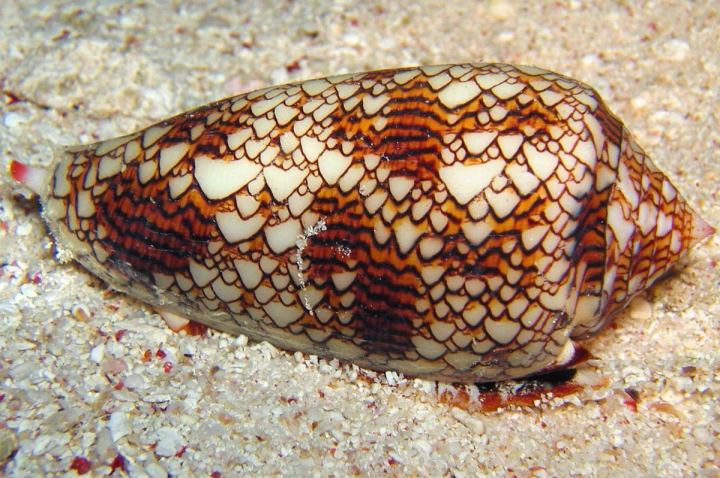
These killer snails possess a neurotoxin powerful enough to easily kill a human. What’s more they have an effective delivery mechanism for this venom – a tiny harpoon. These modified teeth consist of a hollow barb that can be fired in any direction and then reeled back in by the snail. In larger cone snails the harpoon is large and powerful enough to not only penetrate human skin, but gloves or wetsuits too.
The venom of the cone snail are known as conotoxins and contain various neurotoxic agents. These can be very specific to a certain type of nerve and as such are of medical interest. Some cone snail venoms also contain pain-killing properties, which is a nice gesture when you are rapidly dying due to paralysis of the respiratory system! However, most severe stings begin with intense, localized pain. The onset of life-threatening symptoms can take several days.
Over the years cone snails have been responsible for a handful of deaths globally. One story is of somebody picking one up and putting the shell to their ear to listen to the sea. They were dead within minutes. Whether this is a true story or not one species of cone snail is referred to as the “cigarette snail” as if you are stung by one you’ll have just about enough time to smoke one…
9. Cassowary (Casuarius casuarius)

Trust Australia to be home to a bird that can kill you! Second only in size to the ostrich, the cassowary is a man-sized bird. Also in common with the ostrich they are flightless, relying on enormously powerful legs to get them around. Whilst these birds may have a look of giant turkey about them the wild, staring eyes should be enough to put most people off messing with this mega-fowl.
The cassowary’s main weapon is a 5 inch (12cm) long, dagger-like middle toe. I’ll leave it to eminent ornithologist E T Gilliard to describe this:
The inner or second of the three toes is fitted with a long, straight, murderous nail which can sever an arm or eviscerate an abdomen with ease
So, armed with this killer claw, capable of running at speed over 30mph (40km/h) and a track record of aggression this is one chicken not to mess with. Which is exactly what two brothers did in 1926. The teenagers attacked the bird with sticks, one was kicked and the other fell to the ground. Whilst on the ground the boy received a kick to the neck which severed his jugular vein.
8. Stonefish (Synanceia)
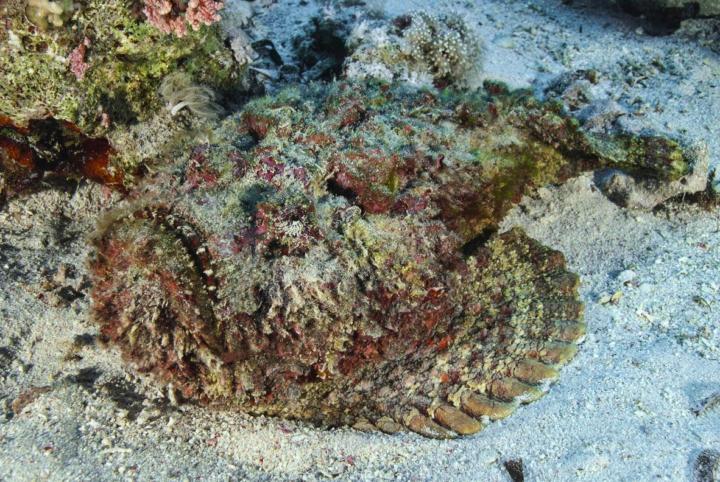
Australia is home to several members of the highly venomous scorpionfish family, Scorpaenidae. Probably the best known of these are the flamboyant lionfish with their elongated fins and bold stripes. However, it is there ugly cousins, the lump-like stonefish that are most venomous (and dangerous) of all.
As the name suggests the stonefish resembles a lump of rock. So good is this camouflage that they are pretty hard to spot even in aquariums when the tank is labelled. Armed with needle-sharp dorsal spines, they often go unnoticed until someone inadvertently steps on one. If this happens the unlucky victim is likely to get a dose of potent neurotoxin to the foot and with it a whole world of pain. So excruciating is the stonefish sting that victims have been reported to demand the afflicted leg be amputated.
Here is one victims experience of being stung by a stonefish:
I got spiked on the finger by a Stonefish in Australia … never mind a bee sting. … Imagine having each knuckle, then the wrist, elbow and shoulder being hit in turn with a sledgehammer over the course of about an hour. Then about an hour later imagine taking a real kicking to both kidneys for about 45 minutes so that you couldn’t stand or straighten up. I was late 20s, pretty fit physically and this was the tiniest of nicks. Got sensation back in my finger after a few days but had recurrent kidney pains periodically for several years afterwards.
Not only is the stonefish sting incredibly painful, it is also potentially deadly. Whilst those getting stung in the foot may get away with a new definition of pain, a sting to the chest or abdomen can easily be fatal. The good news is there is an antivenom; in fact it is the second most frequently administered in Australia.
7. Sydney Funnel Web Spider (Atrax robustus)
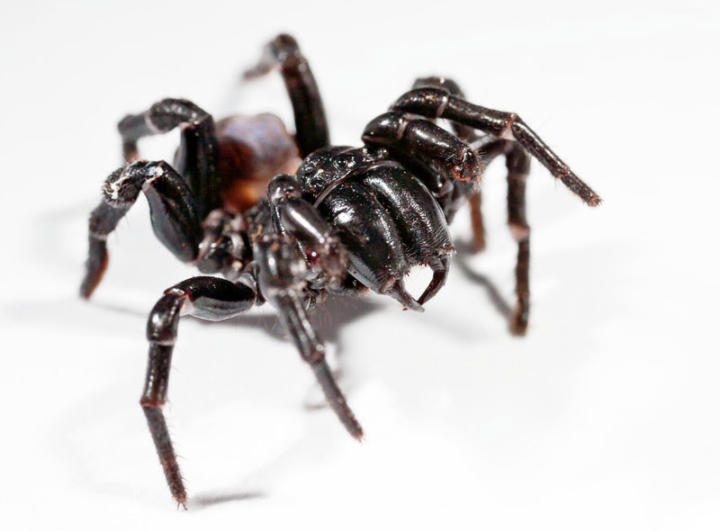
Australia is well known for its creepy-crawlies and in particular its spiders. All the bugs here are bigger, quicker and nastier than most other places on earth. Heading up the list though is the Sydney funnel web spider. Whilst the funnel web is actually responsible for less bites than the notorious redback spider, the funnel web wins out with its stronger venom which it is much more capable of delivering. But it is the Sydney funnel web’s well earned reputation of being one of the world’s most aggressive spiders that truly sets it apart.
The venom of the funnel web is a powerful neurotoxin, reportedly twice as strong as cyanide. Strangely the poison is more or less harmless to rats, rabbits and cats and some other animals. To humans however it is capable of attacking the nervous system effecting any of the body’s organs. It works by preventing nerve impulses being switched off resulting in convulsions. Although many bites seem to have little serious effects on humans the most serious cases have resulted in death in as little as 15 minutes.
Along with that venom go a set of prodigious fangs. Strong, sharp and as long as some snakes fangs these are the stuff of legends. It is said they are capable of piercing a fingernail or shoe leather. Combined with the funnel web’s aggressive behaviour and propensity to cling on, delivering multiple bites this is one to avoid.
In case that has put you off visiting Sydney, you’ll be pleased to know there is an antivenom and no one has died from a bite since it was created in 1981.
6. Drop Bear (Thylarctos plummetus)
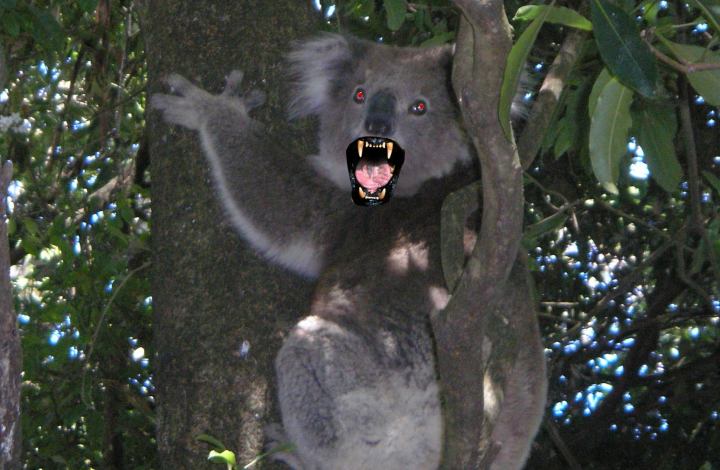
I expect you already knew that those cuddly little koalas are actually quite vicious, well when they can be bothered. Well imagine an enormous, carnivorous koala that lurks amongst the treetops waiting to pounce on its unsuspecting victim. That’s exactly what the drop bear is!
Approximately the same size as a large dog, the drop bear is found in the remote forested regions of the Great Dividing Range in South-eastern Australia. It generally avoids human habitation and confirmed sightings are rare.
The drop bear’s mode of attack is to wait in ambush high in trees. When it spots potential prey it will plummet down on top of it, stunning it before finishing it off with a bite to the neck. Prey are believed to be mainly large mammals. Although they do not specifically target humans there have been reports of attacks resulting in injury, but no fatalities.
Research suggests the drop bear is less likely to attack Australian residents than tourists and this is thought to relate to their aversion to Vegemite. One study by the University of Tasmania goes as far as to suggest smearing Vegemite in the armpits and behind the ears to reduce the likelihood of attack.
More information on the drop bear can be found on the Australian Museum and Australian Geographic websites.
5. Blue-Ringed Octopus (Hapalochlaena)
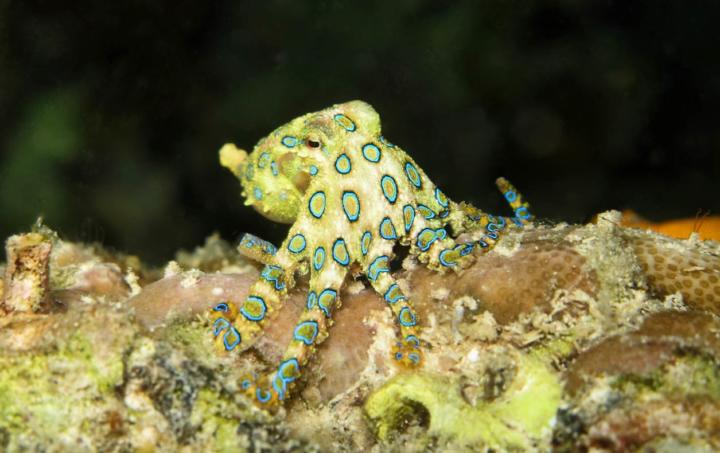
Whilst these little octopuses are instantly recognizable by their iridescent blue rings it spends most of its time camouflaged against coral reefs or hiding in crevices. It is only when agitated that the blue-ringed octopus shows its true colours. Then its skin becomes a bright yellow and the blue rings even more vivid, almost appearing to pulsate. Beautiful as this display might be it is also a warning that this is one of the most dangerous animals in the ocean. Unlike many of Australia’s other dangerous creatures, the blue-ringed octopus is most abundant in the south making contact with humans that bit more likely.
What makes this octopus so dangerous is its venom. Known as TTX (tetrodotoxin) this incredibly strong neurotoxin is the same as that found in arrow poison frogs and pufferfish. At around 1200 times more potent than cyanide it only the slightest nick from a blue-ringed octopus can be fatal. In fact many victims claim not to have even felt the bite itself.
It is said an average specimen weighing around 30g contains enough poison to kill over 10 adults.
There is no effective antivenom for a blue-ringed octopus and the neurotoxin works by paralysing the victim. The danger here is that it paralises the lungs causing the victim to suffocate. Swift treatment is essential in serious cases and this involves putting the victim on life support until the effects of the poison wear off and unassisted breathing is restored.
4. Box Jellyfish
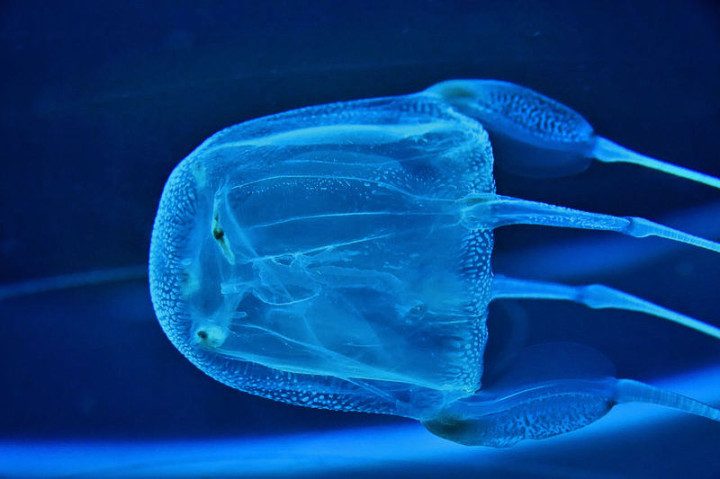
Box jellyfish are actually a number of species so named for their cube shaped bodies. Several of these species possess particularly dangerous stings but it is the large sea wasp (Chironex fleckeri) which has the most powerful sting. Found all along the northern coasts of Australia the sea wasp is the bane of beach-goers during the summer “stinger season” which runs from October to May.
The venom of the sea wasp is the second most powerful of any animal (the geographic sea cone is first) and the sting can on occasion prove fatal. It is estimated that each animal contains enough venom to kill 60 adult humans. In extreme cases death by cardiac arrest has occurred in less than five minutes after being stung. The sting itself causes excruciating pain along with a burning sensation likened to being branded with a red hot iron. Contrary to popular belief, urinating on the sting has no discernible effect! In many cases the tentacles remain attached to the victim and can continue stinging even after they have left the sea often leading to scarring.
Over the last 150 years there have been somewhere between 60 and 80 deaths attributed to this box jellyfish in Australia. Things have improved over recent years with the introduction of an antivenom which is administered in serious cases.
A lesser known menace is the tiny Irukandji jellyfish. With a body measuring less than 5mm these little box jellies pack a powerful sting with venom over 100 times stronger than that of the cobra. Whilst reportedly not too painful, the sting is potentially lethal with 2 confirmed fatalities in Australia. One complication is the possibility of Irukandji syndrome which as well as all the usual unpleasant poisoning symptoms is said to give victims a “feeling of impending doom”.
3. Sharks
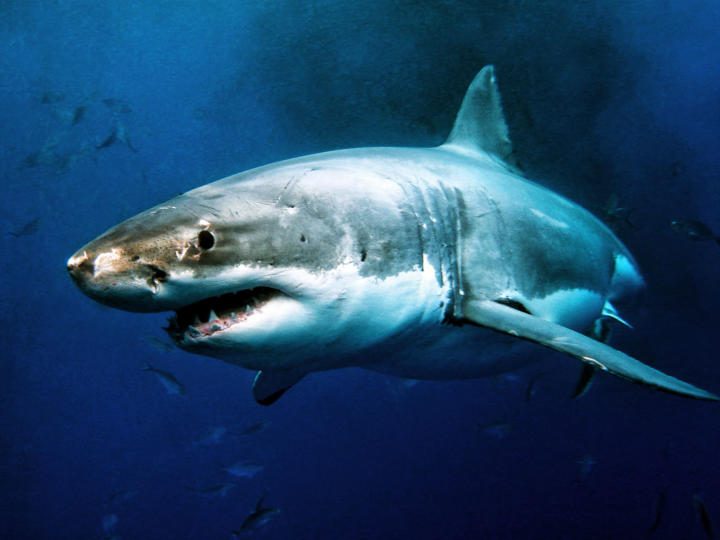
Everybody knows Australia is shark infested. Along with South Africa it probably has the worst reputation for shark attacks of anywhere in the world. All of the big three can be found here and all have been responsible for a catalogue of deaths and attacks over the years. In terms of numbers it is the bull shark that has the worst record, however the great white and the tiger shark are probably the most fearsome to come face to face with.
As a rule there seem to be a few hot spots around the coast where the various shark species present more of a risk. For great whites these are mostly in south, west and mid-east Australia, whereas the tiger shark is limited to the tropical north. The bull shark however appears to be a little more random and what makes these predators particularly scary is they are equally happy in freshwater. These brutes infest the Brisbane river, have attacked people in Sydney Harbour and there have been a multitude of attacks by bull sharks in the waterways and creeks of the Gold Coast. Bull sharks were even seen swimming in the streets of Brisbane after heavy flooding in 2010.
Despite the bull shark’s promiscuous record it is the great white shark which strikes the most fear into people’s hearts. Historically referred to as the “great white death” this shark has been responsible for more fatal attacks than any other species in Australia. Potentially deadly at less than 2 metres (6ft) these monsters can reach over 5 metres (17ft).
2. Eastern Brown Snake (Pseudonaja textilis)
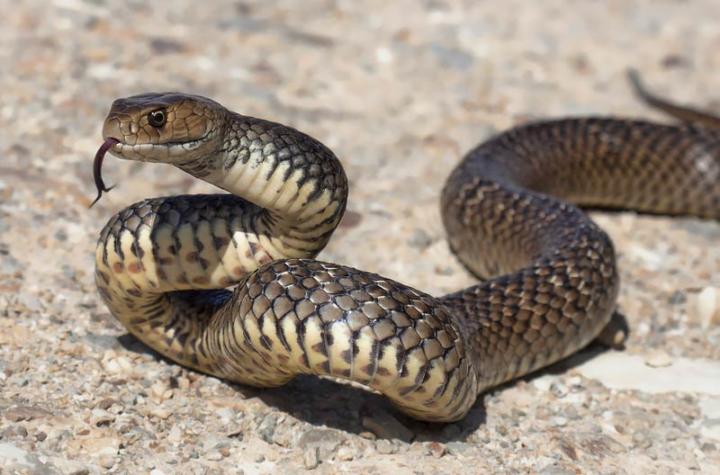
Whilst many people will tell you that the inland taipan is Australia’s most dangerous snake we would disagree. The inland taipan may have the most powerful venom of any snake, however it inhabits extremely remote areas and is not particularly aggressive.
It is the second most venomous land snake on earth that we would rate as Australia’s most dangerous, the eastern brown snake. Much bigger and more common than the inland taipan, the brown snake is also notoriously bad tempered. These fast, aggressive snakes are responsible for over half of all snake deaths in Australia, which averages out at about two a year.
One of the biggest problems with the eastern brown is that it is often found in populated areas. Basically anywhere in NSW, Victoria and Queensland where there are plenty of mice there will also be brown snakes. Despite their venom being designed to kill small mammals it is extremely effective on humans too. Before the advent of an anti-venom in excess of 80% of cases of envenomation resulted in death, often within an hour.
Other deadly snakes worth considering are the tiger snake and the aptly named death adder both of which have been responsible for a number of deaths over the years.
1. Saltwater Crocodile (Crocodylus porosus)
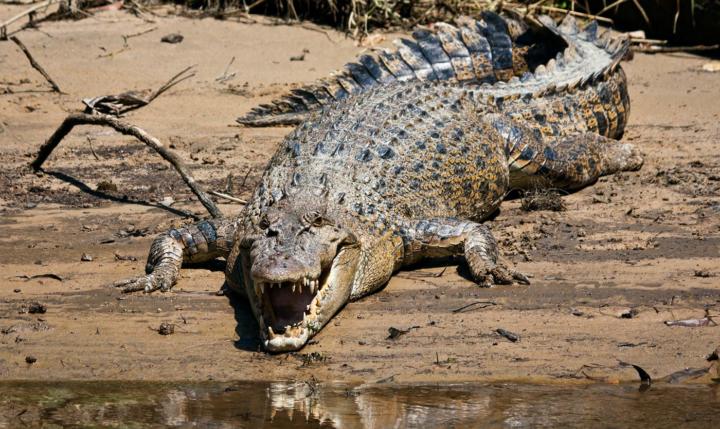
It was a bit of a toss-up as to which order snakes, sharks and crocs came in. Whilst sharks actually kill around twice as many people on average as crocodiles in Australia I’d guess this is just because there are more people in the sea than the croc-infested rivers and coast of the far north of Australia.
The “saltie” is the largest living reptile on earth and it really is a glimpse back to the time of the dinosaurs. The largest authenticated specimens measured nearly 7 metres (25ft) and weighed in at 2 tons. Back in the 1950s one crocodile measuring 8.5 metres (30ft) was allegedly caught in a river near Darwin.
With this size comes massive power and the saltwater crocodile has the most powerful bite on earth – 10 times that of the great white. This is combined with a fair turn of speed too – up to 18mph (27k/ph) in the water which is three times faster than even the fastest Ozzie swimmer. Urban myth states that saltwater crocs can run as fast as race horses. This is completely untrue, but they can burst into action faster than you can blink covering several metres before their prey even has time to react.
There are other reasons to fear the saltwater crocodile too. Firstly, unlike sharks, which usually mistake humans for something tasty, you are firmly on the menu. Salties are opportunistic hunters and will eat virtually anything that moves. And that means anything; records of salties taking tigers, sharks and even an elephant exist.
On top of this prodigious appetite is the fact they are smart, well comparatively anyway!
One last thing to ponder is the croc’s range. These monsters are as happy in the open sea as the swamp so think twice before venturing into the water anywhere in northern Australia – unlike the guy who went for a swim in the croc infested Mary River. As the local police chief said, “You don’t swim in the Mary River”…
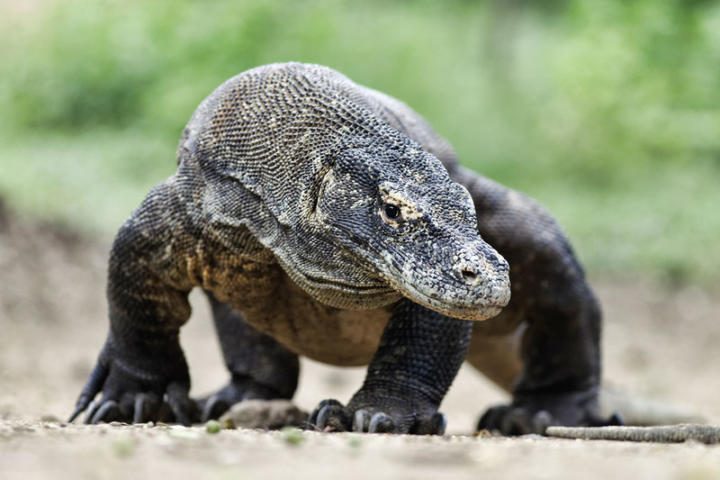

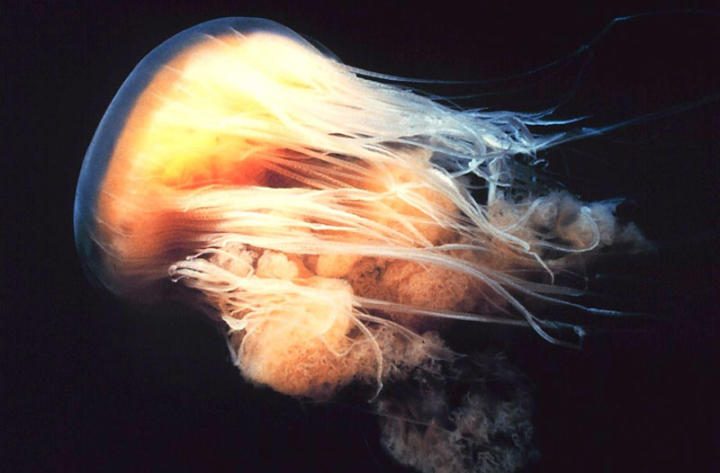
the real top ten dangerous animals in Australia
10. stonefish
9. blue ringed octopus
8. brown snake
7. bull shark
6. mosquito
5. taipan
4. honey bee
3. estuary crocodile
2. box jellyfish
1. great white shark
Australia has 21 of the world’s 25 deadliest snakes.
Australia’s most poisonous /dangerous animals (not just to humans!)
Bluebottle jellyfish
Box jellyfish
Irukandji jellyfish
Sting ray
Common lungfish
Blue-ringed octopus
Smooth toadfish (pufferfish)
Stonefish
Reef stonefish
Cone shell sea snails
Bull shark
Great white shark
Saltwater crocodile
Freshwater crocodile
Redback spider
Huntsman spider
Wolf spider
Sydney funnel-web spider
Black house spider
Bird eating spider
White-tailed spider
Mouse spider
Inland taipan snake
Eastern taipan snake
Coastal taipan snake
Common tiger snake
Eastern brown snake
Red-bellied black snake
Yellow-bellied sea snake
Beaked (hook-nosed) sea snake
Death adder snake
Dugite snake
Goanna
Cane toad
Arrow poison frog
Bull ants
Paralysis tick
European wasp
Giant centipede
Scorpian
Platypus
Drop Bears ! lol now I have to make a sign : “Beware of Drop Bears”. I cannot stop laughing. Nice way to lighten the mood, especially love the Vegemite bit.
I know that the koala is Vicious but that mouth- looks very photo shopped. I wasn’t really scared of a majority of these but next time you shouldn’t Photoshop any of the pictures. Other-wise good information.